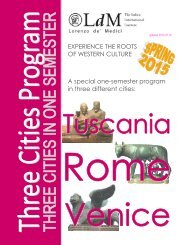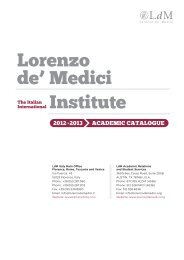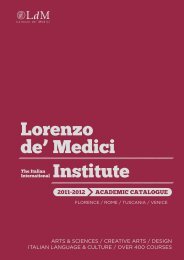aCademiC Catalog 2013-2014 - Lorenzo de Medici
aCademiC Catalog 2013-2014 - Lorenzo de Medici
aCademiC Catalog 2013-2014 - Lorenzo de Medici
Create successful ePaper yourself
Turn your PDF publications into a flip-book with our unique Google optimized e-Paper software.
TUSCANIA<br />
School of Creative Arts<br />
Culinary and Nutritional Arts<br />
The Food of Italy<br />
NUH 160 T<br />
Cr: 3; Contact hrs: 45<br />
Although characterized by unique and distinctive features,<br />
Italian cuisine is still perceived as the result of many different<br />
regional culinary traditions that, although merged and diluted<br />
over the centuries, still maintain their particular flavors and<br />
distinct ingredients. The course focuses on the different<br />
aspects of regional food in Italy, from ingredients to recipe<br />
preparation and cooking techniques, with particular attention<br />
to the following factors: historical origins and <strong>de</strong>velopments;<br />
climate and environmental conditions; social issues; food<br />
production; nutrition; and safety and health. Emphasis will be<br />
placed on how food relates to the local lifestyle and culture.<br />
Regional economy and local resources will be analyzed and<br />
compared. Stu<strong>de</strong>nts will be introduced to the various local<br />
products through lectures and class <strong>de</strong>monstrations.<br />
Wine and Culture I: Wines of Italy<br />
NUH 170 T<br />
Cr: 3; Contact hrs: 45<br />
Despite the ancient origins of wine production in Italy, it is only<br />
recently that Italy has experienced a tremendous improvement<br />
in the quality of its wines. This course introduces stu<strong>de</strong>nts<br />
to wine appreciation techniques, by studying the most<br />
representative wines of the regions of Italy. History, production,<br />
grapes, labeling, and tasting methods will be discussed.<br />
Mediterranean Cuisine<br />
NUH 217 T<br />
Cr: 3; Contact hrs: 45<br />
This course explores the richness and diversity of Italian cuisine<br />
in the context of Mediterranean culture. The course focuses on<br />
different aspects of regional foods in Italy, while at the same<br />
time drawing links between Italian cuisine and that of the<br />
Middle East and North Africa. Landscape, the vegetation and<br />
the climate constantly change to produce significant products<br />
and recipes. The influence of Etruscans, Greeks and Romans<br />
on Mediterranean cuisine will be examined. Practical classes<br />
will provi<strong>de</strong> an overview of the <strong>de</strong>licious and healthy dietary<br />
mo<strong>de</strong>ls of the countries concerned. The fundamental role of<br />
herbs and spices in Mediterranean cooking will be examined,<br />
and stu<strong>de</strong>nts will learn how to cook several kind of fishes and<br />
meats. The role of wine in Italian and Mediterranean cuisine will<br />
also be explored.<br />
Vegetarian Cuisine of Mediterranean<br />
Countries<br />
NUH 218 T<br />
Cr: 3; Contact hrs: 45<br />
Vegetarian cooking has extraordinarily increased in popularity<br />
in recent years. Throughout the course stu<strong>de</strong>nts will learn<br />
to prepare a variety of vegetable dishes. Using different<br />
techniques such as grilling, broiling, steaming, sautéing, baking,<br />
and frying, we will discover how to make fantastic vegetarian<br />
whole meals. The menu inclu<strong>de</strong>s dishes prepared with fruits,<br />
cereals, legumes, eggs, cheese and other grain products.<br />
Special emphasis is placed on strategies to create flavors by<br />
using vegetable stocks, herbs, spices, oils and seasoning.<br />
Current Trends in Italian Cuisine<br />
NUH 220 T<br />
Cr: 3; Contact hrs: 45<br />
This course explores major trends in contemporary Italian<br />
cuisine that have been emerging in recent <strong>de</strong>ca<strong>de</strong>s. These<br />
trends, revealed in both everyday and haute cuisine, involve<br />
fresh reinterpretations of regional traditions, revaluation of local<br />
products, interest in lighter and healthier diet, and an emphasis<br />
on creativity. Driving these trends are such diverse factors as<br />
interest in other cuisines, innovations by leading chefs, and<br />
especially changes in Italian society and lifestyles. Stu<strong>de</strong>nts<br />
learn basic cooking skills as well as some specialized cooking<br />
methods and techniques. They discover how to select quality<br />
ingredients, and they compare their eating habits with those<br />
common in Italy today. Particular focus is given to the following<br />
aspects: historical origins and <strong>de</strong>velopments of food production,<br />
regional dishes, seasonal and environmental conditions, social<br />
issues, nutrition, safety and health. In each lesson stu<strong>de</strong>nts<br />
learn how to prepare representative recipes, with attention to<br />
ingredients, nutritional values, and presentation.<br />
Mediterranean Desserts<br />
NUH 223 T<br />
Cr: 3; Contact hrs: 45<br />
Traditional and home pastry making such as gelato, yoghurt<br />
gelato, granite, and sorbetti will be studied in this course.<br />
“Desserts” are a collective name for sweet dishes consi<strong>de</strong>red<br />
suitable for the last course of a meal, including cakes, ice<br />
creams, creams, raw and cooked fruit, puddings, pastries, and<br />
pies. Cheeses have also been inclu<strong>de</strong>d amongst <strong>de</strong>sserts. In<br />
Britain, “<strong>de</strong>ssert” is sometimes regar<strong>de</strong>d as an elegant synonym<br />
for the words “pudding”, or “sweet”. The word <strong>de</strong>rives from<br />
French <strong>de</strong>sservir, meaning to remove the dishes, or clear the<br />
table.<br />
Fish and Shellfish from the Mediterranean Sea<br />
NUH 228 T<br />
Cr: 3; Contact hrs: 45<br />
The use and the cooking of fish, shellfish and crustaceans have<br />
always played a fundamental role in Mediterranean cuisine.<br />
Italians chefs are amongst the best cooks in the world, together<br />
with the Japanese, in the preparation and cooking of fish and<br />
shellfish. The Japanese are so good in managing fresh, raw fish,<br />
that they are masters in the preparation of sushi and sashimi.<br />
This cooking method forms a flavorful harmony with the Italian<br />
and Mediterranean cooked fish techniques. The stu<strong>de</strong>nts will<br />
not only learn how to recognize fresh fish, and know the right<br />
kind of fish suitable for the type of recipe, but they will also<br />
learn how to cook with herbs and spices to zest up the simplest<br />
fish dishes. Stu<strong>de</strong>nts will create recipes and take care of their<br />
own buying of fresh fish and aromatic herbs to season the<br />
recipes.<br />
Etruscan Cuisine<br />
NUH 233 T<br />
Cr: 3; Contact hrs: 45<br />
This is an introduction to the ancient traditions of the highly<br />
civilized Etruscan cuisine, through literature and archaeology.<br />
Practical recipes are focused on cereals and legumes, and<br />
vegetable and fruits dishes. Meats, seafood, <strong>de</strong>sserts, and<br />
serving traditions will also be studied.<br />
Bread Making in the Mediterranean Tradition<br />
NUH 238 T<br />
Cr: 3; Contact hrs: 45<br />
This course is an introduction to the major contemporary<br />
and traditional preparations of several kinds of Italian and<br />
Mediterranean types of bread. Stu<strong>de</strong>nts will study different<br />
ways of making a typical bread dough and the new special<br />
techniques coming from the Middle Eastern counties. The<br />
course will also look at the Mediterranean ‘hand ma<strong>de</strong>’ way<br />
of kneading and eating bread and its evolution over time.<br />
Stu<strong>de</strong>nts will learn how to prepare numerous types of dough,<br />
principal elements and the best ingredients to make a proper<br />
regional Italian loaf.<br />
Cooking Grains in Mediterranean Style<br />
NUH 243 T<br />
Cr: 3; Contact hrs: 45<br />
This course concerns the art of preparing Italian rice and<br />
risotto, Mediterranean couscous, Middle Eastern bulgar, and<br />
si<strong>de</strong> dishes using pearl barley, millet and spelt. Simple plate<br />
presentation based on vegetables, sophisticated recipes with<br />
shellfish, and <strong>de</strong>licate consommés fit for the most exclusive<br />
gala dinners will be prepared. Basic rules for preparation of the<br />
most important soups and minestrone of the traditional and<br />
mo<strong>de</strong>rn Italian cuisine will be looked at. Recipes inclu<strong>de</strong> grain<br />
soups (e.g. Minestra di farro e orzo ai fiori di zucca and crema<br />
al basilico), a vegetable soup (e.g. Zuppa di primizie al profumo<br />
di salvia, and a smooth cream (e.g. Crema di zucchine, gamberi<br />
e melone d’inverno). Stu<strong>de</strong>nts will learn about the best rices<br />
168<br />
LdM Aca<strong>de</strong>mic <strong>Catalog</strong> <strong>2013</strong>-<strong>2014</strong>





